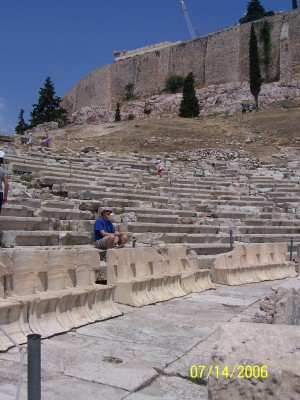|
Theatre
of Dionysos
 Sitting
at the foot of the Acropolis (part of the Parthenon is visible
in this picture) are the remains of the theatre Dionysos. This
theatre was built in the 5th century BC and housed many of the
famous Greek plays by Aristophanes, Euripedes, and Sophocles.
Later on it would host the Athenian democratic assembly. Sitting
at the foot of the Acropolis (part of the Parthenon is visible
in this picture) are the remains of the theatre Dionysos. This
theatre was built in the 5th century BC and housed many of the
famous Greek plays by Aristophanes, Euripedes, and Sophocles.
Later on it would host the Athenian democratic assembly.
How is the theatre of Dionysos
significant for understanding the world of Paul?
Theater began not as a public telling of various stories but as
the religious reenactment of the specific story of Dionysos. As
the book, Ancient Greece, the monuments then and now writes, “At
first the rituals related to Dionysos' adventures, his death and
resurrection, that is to vegetation and fertility in Nature, and
their aim was to purify and revive the life forces...”
 How is Paul not adapting the Dionysos myth to Christian
teachings?
How is Paul not adapting the Dionysos myth to Christian
teachings?
A casual web search reveals all sorts of anti-Christian websites
touting Jesus' resurrection as a simple adaptation of Dionysos'
resurrection. While Christians must admit that other cultures
possess stories of death and resurrection, the crucifixion and
resurrection of Jesus differs in significant ways from the death
and resurrection of Dionysos.
First, Dionysos is not an adult when he dies; he is a baby
killed by his father's wife (she, Hera, is not Dionysos' mother,
but angry and jealous of her husband's mistress). Dionysos
has no clue that his father, Zeus, will take his heart (that
another God saved) and remake him. Jesus is a full-grown adult
conscious of his death and resurrection.
Second, Dionysos does not willingly sacrifice himself for
others. Hera seduces him with toys. Jesus willingly dies.
Third, Dionysos did not die with any plan for creation,
salvation or redemption in mind. Jesus did.
Fourth, Dionysos' resurrection is not associated with the
resurrection of believers but the resurrection of good weather,
crops and spring. Jesus did not die on the cross to ensure crops
grew in the Spring. Christians believe that God did this
long before Jesus dwelt among us:
In the Old Testament: He covers the heavens with
clouds, prepares rain for the earth, makes grass grow on the
hills. He gives to the animals their food, and to the
young ravens when they cry. Psalm 147:8-9
From Jesus' mouth: For he makes his sun rise on
the evil and on the good, and sends rain on the righteous and on
the unrighteous. Matthew 5:45
Fifth, Dionysos dies every year at the harvest and returns in
the spring. Jesus died once and for all.
Sixth, Dionysos worship culminated in ecstatic worship which
included orgies and tearing apart the animal sacrifice.
Seven, Dionysos never bids his worshippers to lose their own
lives as Jesus does.
For those who want to save their life will lose it, and those
who lose their life for my sake, and for the sake of the gospel,
will save it. Mark 8:35
sources:
info on rituals and theater:
Drosou-Panayotou, Niki. Ancient Greece, the monuments then
and now. Athens: Papadimas Dim., 2006.
info on resurrection story of dionysis:
http://www.geocities.com/Athens/Parthenon/2226/Greek/dionysis.html
http://www.proudtobepagan.com/sabbats.htm
|



 Sitting
at the foot of the Acropolis (part of the Parthenon is visible
in this picture) are the remains of the theatre Dionysos. This
theatre was built in the 5th century BC and housed many of the
famous Greek plays by Aristophanes, Euripedes, and Sophocles.
Later on it would host the Athenian democratic assembly.
Sitting
at the foot of the Acropolis (part of the Parthenon is visible
in this picture) are the remains of the theatre Dionysos. This
theatre was built in the 5th century BC and housed many of the
famous Greek plays by Aristophanes, Euripedes, and Sophocles.
Later on it would host the Athenian democratic assembly.